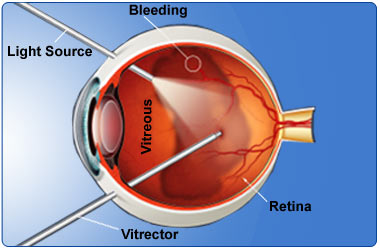Treatment
Surgery is the treatment of choice for retinal detachment. There are various surgical modalities depending on the cause of retinal detachment.
The hole or tear is sealed with cryotherapy or laser depending on the position of the break. Anterior or more peripheral breaks are easily tackled with cryotherapy. The posterior breaks are sealed with laser therapy.
Various types of surgeries are done to hold the break against the outer coats of the eye ball (tamponade) for permanent closure. They are as follows:
- External tamponade: Scleral buckling
- Internal tamponade:
- Pneumatic retinopexy
- Vitrectomy with air or silicon oil tamponade
Scleral buckling: The hole or tear is first sealed with cryo or laser therapy following which sclera buckling is done. It is a surgical procedure in which a silicone band or sponge is sewn around the eyeball a little behind the visible portion or the eye. The surgeon first exactly locates the hole and places the band and tightens it creating a buckle effect. The outer coats of the eye are indented and in this way the hole in the retina approximates the outer scleral coat.

Drain: The fluid that seeps out through the hole behind the retina can be drained with a small slit made in the outer coats of the eye to flatten the retina. This procedure called sub-retinal fluid drain is usually done along with sclera bucking to flatten the retina.
Pneumatic Retinopexy: It is a short simple procedure in which a fixed amount of air is injected in the posterior part of the eye which acts as an internal tamponade helping to push and approximate the tear with the outer coat of the eye ball. Following which the tear is sealed with cryo or laser therapy. Post-operatively the patient is advised rest in a specified position so as to facilitate the air bubble to push the desired area of the retina with the tear against the sclera.

Vitrectomy: Retinal detachments due to advanced diabetic eye disease, trauma, endopthalmitis, traction, giant retinal tears and detachments associated with vitreous hemorrhage require this specialized surgical procedure called vitrectomy. The procedure involves cutting and removal of the vitreous gel along with removal of all the fibrous tissue causing traction (pull) on the retina and detaching it. It is done with the help of micro instruments and a fiberoptic light source. Following which the space is replaced with gas or silicon oil. Sometimes the procedure is combined with sclera buckling.









